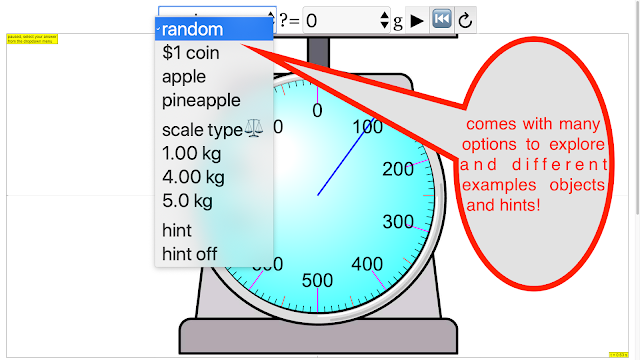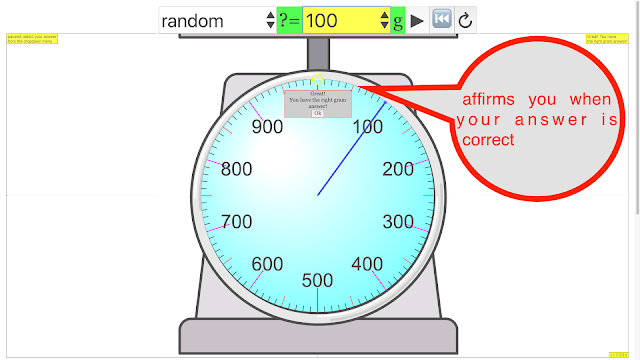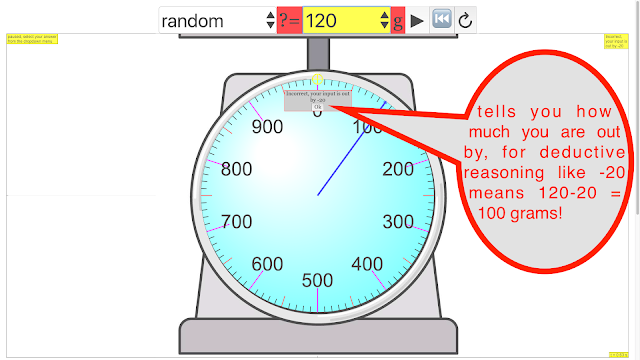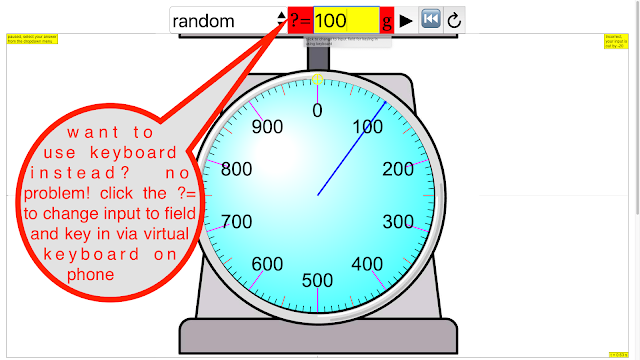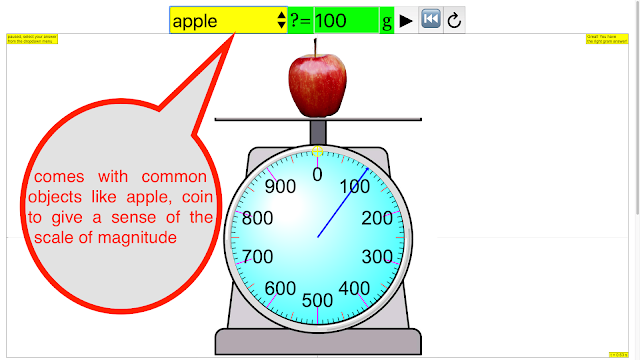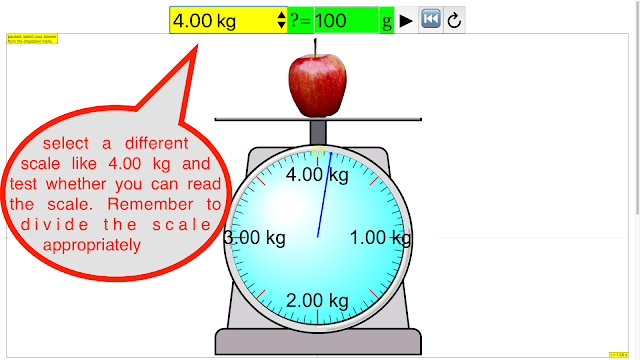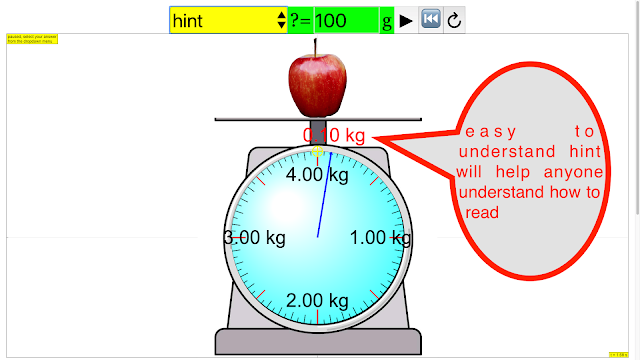https://iwant2study.org/moodle402/mod/laejss/view.php?id=37
Translations
| Code | Language | Translator | Run | |
|---|---|---|---|---|
 |
||||
Credits
 lookang
lookang
Main Themes and Important Ideas/Facts:
- Interactive Learning Tool: The core of this resource is an interactive JavaScript simulation of a 5 kg mass or weighing scale. The description explicitly states, "Play with the Mass Scale Model. Test what you've learned by trying the input field." This highlights the hands-on nature of the tool, allowing users to actively engage with the concept of measuring mass.
- Focus on Reading Scales: The primary objective of the simulation is to develop the "skills of reading from a circular scale of a typical weighing scale." This indicates a focus on the fundamental skill of interpreting analog measurement instruments.
- Customizable Precision: The applet offers flexibility by providing "three options available allows for student's own testing of the different scales with different decimal places of precision appropriate in each scale's smallest division." This feature is crucial for understanding the concept of accuracy and significant figures in measurement.
- Addressing Common Misconceptions: The resource directly addresses a common student difficulty: "Students typically can tell masses of whole numbers such as 600 g, but to be able to type in 0.60 kg requires some understanding of decimal places." This demonstrates an awareness of specific learning challenges and implies the simulation aims to bridge this gap.
- Alignment with Learning Goals: The applet supports specific learning objectives, such as being able to "(g) describe how to measure a variety of masses with appropriate accuracy by means of weighing scales." This links the simulation to established educational standards and curriculum goals.
- Accessibility and Platform Compatibility: The applet is designed to be accessible across various devices, including "Android/iOS including handphones/Tablets/iPads," "Windows/MacOSX/Linux including Laptops/Desktops," and "ChromeBook Laptops." This broad compatibility enhances its potential for widespread educational use. The embed code provided (<iframe width="100%" height="100%" src="https://iwant2study.org/lookangejss/math/ejss_model_shmmassscale_5_kg_version/shmmassscale_5_kg_version_Simulation.xhtml " frameborder="0"></iframe>) further facilitates its integration into online learning environments.
- Integration with Open Educational Resources: The applet is explicitly presented as part of the "Open Educational Resources / Open Source Physics @ Singapore" initiative. This signifies its commitment to free and accessible educational materials. The Creative Commons Attribution-Share Alike 4.0 Singapore License governs the content, promoting sharing and adaptation with appropriate attribution.
- Supporting Measurement Skills: The resource explicitly connects to broader science process skills, listing "measure to obtain a reading from a suitable measuring instrument" under "Topics" and further elaborating on "Observing" and "Using apparatus and equipment" under "Skills Engaging with an event, phenomenon or problem through: Collecting and presenting evidence through:". This contextualizes the applet within a larger framework of scientific inquiry.
- Availability as Apps: The provision of links to Android and iOS apps suggests that the simulation has been packaged for mobile use, further increasing its accessibility for students using different devices.
Quotes from Original Sources:
- Description: "Play with the Mass Scale Model. Test what you've learned by trying the input field."
- Description: "This Mass Scale Model allows the skills of reading from a circular scale of a typical weighing scale."
- Description: "The three options available allows for student's own testing of the different scales with different decimal places of precision appropriate in each scale's smallest division."
- Common misconceptions: "Students typically can tell masses of whole numbers such as 600 g, but to be able to type in 0.60 kg requires some understanding of decimal places."
- Sample Learning Goals: "(g) describe how to measure a variety of masses with appropriate accuracy by means of weighing scales."
- Skills: "Observing This is the skill of using our senses to gather information about objects or events. This also includes the use of instruments to extend the range of our senses."
- Skills: "Using apparatus and equipment This is the skill of knowing the functions and limitations of various apparatus, and developing the ability to select and handle them appropriately for various tasks."
Related Resources and Credits:
The page provides links to related resources on GeoGebra and credits the developer "lookang" and sources for images used in the simulation. It also mentions the Easy Java/JavaScript Simulations Toolkit used for its development.
Conclusion:
The "Mass or Weighing Scale 5 kg version only" simulation applet is a valuable interactive tool for teaching and learning the fundamental skill of reading a weighing scale. Its focus on addressing common misconceptions, customizable precision levels, broad accessibility, and alignment with learning goals make it a useful resource for educators in primary and potentially lower secondary education. Being part of the Open Educational Resources / Open Source Physics @ Singapore project further enhances its value by providing free and adaptable educational material.
Study Guide: Mass and Weighing Scales
I. Key Concepts
- Mass: The amount of matter in an object. It is a fundamental property and remains constant regardless of location.
- Weight: The force exerted on an object due to gravity. Weight can change depending on the gravitational field.
- Weighing Scale: A measuring instrument used to determine the mass of an object by comparing its weight to a known standard mass or by measuring the force exerted by the object due to gravity.
- Circular Scale: A type of display on a weighing scale where the measurements are arranged in a circular or arc pattern, and a pointer indicates the measured value.
- Decimal Places: The number of digits to the right of the decimal point, indicating the precision of a measurement.
- Precision: The degree of refinement in a measurement, determined by the smallest division on the measuring instrument.
- Measuring Instrument: A tool or device used to quantify physical quantities, such as mass, length, or volume.
- Observation: The skill of using senses (and instruments to extend them) to gather information about objects or events.
- Using Apparatus and Equipment: The skill of understanding the functions and limitations of various tools and being able to select and handle them appropriately for specific tasks.
- Reading: The process of interpreting the value displayed by a measuring instrument.
II. Quiz
Answer the following questions in 2-3 sentences each.
- What is the primary purpose of a weighing scale as described in the source material?
- According to the text, what is a common misconception students have when dealing with mass measurements?
- What skill is specifically mentioned in relation to obtaining a reading from a measuring instrument?
- Besides direct observation using senses, what else is included in the skill of observing?
- What does the skill of "using apparatus and equipment" involve?
- The description of the Mass Scale Model mentions "different decimal places of precision." Why is understanding decimal places important when using such a scale?
- What type of scale display is specifically mentioned in the description of the simulation applet?
- What are some examples of apparatus and equipment one might use in a science context beyond just a weighing scale?
- According to the "Sample Learning Goals," what should students be able to do with weighing scales?
- What does the provided HTML iframe code allow a user to do with the Mass Scale Model?
III. Quiz Answer Key
- The primary purpose of a weighing scale, as described, is to measure the mass of an object. The simulation applet specifically aims to develop the skill of reading from the circular scale of a typical weighing scale.
- A common misconception among students is being able to identify whole number masses like 600 g but struggling to represent the same mass using decimals in kilograms, such as 0.60 kg. This highlights a difficulty with understanding decimal places in the context of mass units.
- The skill specifically mentioned in relation to obtaining a reading from a measuring instrument is simply the act of "measure to obtain a reading from a suitable measuring instrument." This implies the ability to correctly interpret the scale's markings.
- Beyond using our basic senses (sight, touch, etc.), the skill of observing also includes the use of instruments to extend the range and accuracy of our sensory perceptions when gathering information about objects or events.
- The skill of "using apparatus and equipment" involves knowing what different tools are for and what their limitations are. It also includes developing the ability to choose the right tool for a specific job and handle it correctly and safely.
- Understanding decimal places is crucial because the Mass Scale Model allows for testing scales with varying levels of precision indicated by different decimal places in their smallest divisions. This helps in accurately representing and interpreting mass measurements.
- The description of the simulation applet explicitly mentions the skill of reading from a "circular scale" as a feature of a typical weighing scale that the model emulates.
- Examples of other apparatus and equipment in a science context could include thermometers for measuring temperature, rulers or calipers for measuring length, beakers or graduated cylinders for measuring volume, and various sensors for detecting different phenomena.
- According to the "Sample Learning Goals," students should be able to describe how to measure a variety of masses with appropriate accuracy by means of weighing scales. This emphasizes both the process and the level of correctness in measurement.
- The provided HTML iframe code allows users to embed the interactive Mass Scale Model simulation directly into a webpage, making it accessible for others to use and interact with online.
IV. Essay Format Questions
- Discuss the importance of developing skills in observation and the use of apparatus in scientific learning, referencing the provided text and elaborating on why these skills are foundational.
- Explain how interactive simulations, like the Mass Scale Model described, can help address common misconceptions students have about measurement and the use of decimal places in representing quantities.
- Compare and contrast the concepts of mass and weight. How does a weighing scale typically measure mass indirectly, and what assumptions are made in this process?
- Analyze the design and purpose of a circular scale on a weighing instrument. What are the advantages and potential challenges of reading such a scale compared to a digital display?
- Consider the role of open educational resources (OER) like the Mass Scale Model in promoting science education and accessibility to learning tools. What are the potential benefits and challenges of using such resources in a learning environment?
V. Glossary of Key Terms
- Applet: A small application, often written in Java or JavaScript, designed to run within another application, typically a web browser.
- HTML5: The latest evolution of the standard that defines the structure and content of the web. It enables multimedia and interactive elements without the need for plugins.
- JavaScript: A popular programming language commonly used to add interactivity and dynamic effects to websites.
- Simulation: A computer-based model that imitates a real-world system or process, allowing users to interact with it and observe its behavior.
- Open Educational Resources (OER): Teaching, learning, and research materials that are freely available online for anyone to use, adapt, and share.
- Precision: The exactness of a measurement, often indicated by the number of significant figures or decimal places.
- Accuracy: The closeness of a measurement to the true or accepted value of the quantity being measured.
- Circular Scale: A measurement scale arranged in a circular or arc shape, typically with a pointer to indicate the measured value.
- Kilogram (kg): The base unit of mass in the International System of Units (SI).
- Gram (g): A unit of mass equal to one-thousandth of a kilogram.
ame changed to shm instead of SHM capitalisation causing error in App
Apps
https://play.google.com/store/apps/details?id=com.ionicframework.scaleapp217336

https://itunes.apple.com/us/app/even-odd-multiples-factors/id1196575475?ls=1&mt=8 iOS App
Topics
- measure to obtain a reading from a suitable measuring instrument
- Skills Engaging with an event, phenomenon or problem through:
- Collecting and presenting evidence through:
- Observing This is the skill of using our senses to gather information about objects or events. This also includes the use of instruments to extend the range of our senses.
- Using apparatus and equipment This is the skill of knowing the functions and limitations of various apparatus, and developing the ability to select and handle them appropriately for various tasks.
ScreenShots
Mass or Weighing Scale Model JavaScript Simulation Applet HTML5
|
Mass or Weighing Scale Model JavaScript Simulation Applet HTML5 |
|
Mass or Weighing Scale Model JavaScript Simulation Applet HTML5 |
|
Mass or Weighing Scale Model JavaScript Simulation Applet HTML5 |
|
Mass or Weighing Scale Model JavaScript Simulation Applet HTML5 |
|
Mass or Weighing Scale Model JavaScript Simulation Applet HTML5 |
|
Mass or Weighing Scale Model JavaScript Simulation Applet HTML5 |
|
Mass or Weighing Scale Model JavaScript Simulation Applet HTML5 |
|
Mass or Weighing Scale Model JavaScript Simulation Applet HTML5 |
Description
Play with the Mass Scale Model. Test what you've learned by trying the input field.
This Mass Scale Model allows the skills of reading from a circular scale of a typical weighing scale. The three options available allows for student's own testing of the different scales with different decimal places of precision appropriate in each scale's smallest division.
Common misconceptions
Students typically can tell masses of whole numbers such as 600 g, but to be able to type in 0.60 kg requires some understanding of decimal places.
Sample Learning Goals
(g) describe how to measure a variety of masses with appropriate accuracy by means of weighing scales.
Version:
Resources
https://www.geogebra.org/m/p2att6kw by Lew w s
https://www.geogebra.org/m/yphhaxky By lew
Credits
http://weelookang.blogspot.sg/2014/11/ejss-mass-scale-model.html
scale from
http://www.abcteach.com/free/k/kilogramblankscalergb.jpg
http://www.picserver.org/p/pineapple.html
https://commons.wikimedia.org/wiki/File:Single_apple.png
http://fengshuibeginner.com/singapore-1-dollar-coin/
Frequently Asked Questions: Mass or Weighing Scale Simulation
1. What is the primary purpose of the Mass or Weighing Scale 5 kg simulation?
The primary purpose of this interactive simulation is to help users develop and practice the skill of reading measurements from a typical circular weighing scale, specifically a 5 kg version. It offers a virtual environment to engage with different scales and their levels of precision.
2. What key skills does this simulation aim to develop?
This simulation focuses on developing two main skills: first, the ability to accurately measure and obtain readings from a measuring instrument (in this case, a weighing scale); and second, broader scientific engagement skills such as observing (using senses and instruments to gather information) and using apparatus and equipment (understanding functions and limitations, and handling them appropriately).
3. How does the simulation help overcome common misconceptions related to mass measurement?
The simulation directly addresses the common misconception where students can identify whole number masses (e.g., 600 g) but struggle to represent them using decimals in kilograms (e.g., 0.60 kg). By providing options with varying decimal places of precision, it encourages users to understand the relationship between different units and the significance of decimal representation in precise measurement.
4. What are some suggested learning goals associated with using this simulation?
A key learning goal is for users to be able to describe how to measure a variety of masses with appropriate accuracy using weighing scales. The simulation provides a practical way to explore this goal through interactive practice.
5. What are the different ways users can interact with the Mass Scale Model?
Users can interact with the simulation by observing the virtual weighing scale and practicing reading the measurements displayed. The "input field" feature allows users to test their understanding by typing in mass values and observing the corresponding reading on the simulated scale. The availability of different scales with varying decimal places further enhances interactive exploration.
6. Is this simulation accessible on different types of devices?
Yes, the Mass or Weighing Scale Model JavaScript Simulation Applet is designed using HTML5, making it accessible across various platforms and devices. This includes desktops (Windows/MacOSX/Linux), laptops (including Chromebooks), and mobile devices (Android/iOS phones and tablets/iPads).
7. Can this simulation be integrated into other learning platforms?
Yes, the provided embed code (<iframe width="100%" height="100%" src="https://iwant2study.org/lookangejss/math/ejss_model_shmmassscale_5_kg_version/shmmassscale_5_kg_version_Simulation.xhtml " frameborder="0"></iframe>) allows educators to easily embed this interactive model into webpages or other online learning environments.
8. Are there any related resources or credits associated with this simulation?
Yes, the resource acknowledges "lookang" as the primary creator. It also provides links to related GeoGebra resources created by Lew w s, images used for the scale and objects, and credits the Open Educational Resources / Open Source Physics @ Singapore initiative. Additionally, it references the Easy JavaScript/JavaScript Simulations Toolkit and Open Source Physics projects as foundational elements.
- Details
- Parent Category: Measurement and Geometry
- Category: measurement
- Hits: 6091


.png
)






